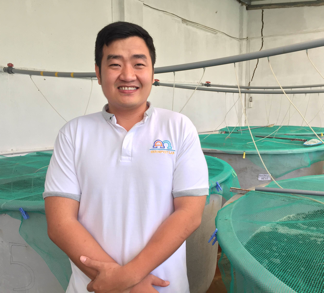|
Doctor: TRAN HUU LOC Email: thloc@hcmuaf.edu.vn Phone: 0913210290 Office: Phượng Vỹ Bldg Room 317
Education background 2006. B.S. Nong Lam University at Hochiminh City, Vietnam (Major: Aquaculture)
2013. PhD, Environmental Sciences and Microbiology (centered on Shrimp pathology), University of Arizona, USA.
Skills and expertise: -Aquaculture pathology -Shrimp farming technology -Genetics and breeding -Environmental science
Teaching course: - Shrimp disease - Non-infectious disease in aquaculture - Technical English
|
Work experience and Responsibilities 2007-2010 Research & Teaching Assistant at Department of Aquatic Animal Pathology, College of Fisheries, Nong Lam University at Ho Chi Minh, Vietnam 2010-2013: Research Associate, Ph.D candidate, College of Agriculture and Life Science, University of Arizona, Tucson, Arizona, USA 2014- 2017: Assistant Professor, Department of Aquatic Animal Pathology, College of Fisheries, Nong Lam University at Ho Chi Minh, Vietnam 2014-2021: Founder, CEO & Chairman: ShrimpVet Laboratory, Minh Phu Aquamekong Co. LtD. ShrimpVet is an innovation company, an independent lab & research center working on shrimp diseases globally. It has 2 diagnostics labs, 3 research centers, 1 hatchery, and 1 demonstration farm in Vietnam. Founder and CEO of Luxneo Biologicals Joint Stock Co. LtD and ShrimpVet Food Joint Stock Co. LtD. Selected publications Han J.E., Tang F.F.J., Lightner D.V. & Tran L. (2015). Photorhabdus insect related (Pir) toxin-like genes in a plasmid of Vibrio parahaemolyticus, the causative agent of acute hepatopancreatic necrosis disease (AHPND) of shrimp. Dis. Aquat. Org., 113, 33–40. Tran L, Nunan L, Redman RM, Mohney LL, Pantoja CR, Fitzsimmons K, and Lightner DV. 2013. Determination of the infectious nature of the agent of acute hepatopancreatic necrosis syndrome affecting penaeid shrimp. Dis. Aqua Org 105 (1): 45-55. Tran H.L, Hoang N.P, Nguyen HT, and Lightner D.V. Study to determine the infection route of the agent of the acute Hepatopancreatic necrosis syndrome (AHPNS) or early mortality Syndrome (EMS). Proceeding of the Vietnam National Conference in Aquaculture, Ho Chi Minh City, 2013. Pg 446-452. Tran L.H, Fitzsimmons K.M, Lightner D.V. Tilapia Could Enhance Water Conditions, Help Control EMS In Shrimp Ponds. Global Aquaculture Advocate Jan/Feb 2014, Pg26-28. Redman Dv Cr Lightner, Carlos Pantoja, Loc Tran, 2012. Biology and pathology of early mortality syndrome of shrimp, Global outlook for aquaculture leadership Documentation of an Emerging Disease (Early Mortality Syndrome) in SE Asia & Mexico Loc Tran, Linda, Nunan, R.M Redman, Kevin Fitzsimmons, and Donald V. Lightner. EMS/AHPNS: Infectious Disease Caused By Bacteria. Global Aquaculture Advocate July/August 2013, Pg18-19. Donald V.Lightner, R.M Redman, C.R Pantoja, Loc Tran. Early Mortality Syndrome affects shrimp in Asia.Global Aquaculture Advocate Jan/Feb 2012, Pg40-41. Thinh N.H., Kuo T.Y., Hung L.T., Loc T.H., Chen S.C., Evensen O., Schuurman H.J. 2009. Combined immersion and oral vaccination of Vietnamese catfish (Pangasianodon hypophthalmus) confers protection against mortality caused by Edwardsiella ictaluri. Fish and Shellfish Immunology, v27 n6 (2009): 773-776. Nhan D.T, Loc T.H, Mathieu Wille, Patrick Sorgeloos, 2009. Larval quality of Macrobrachium rosenbergii obtained from different broodstock geographical origins. Proceeding of the Vietnam National Conference in Aquaculture, Ho Chi Minh City, 2009. 432-440.
|
Page count: 4688

